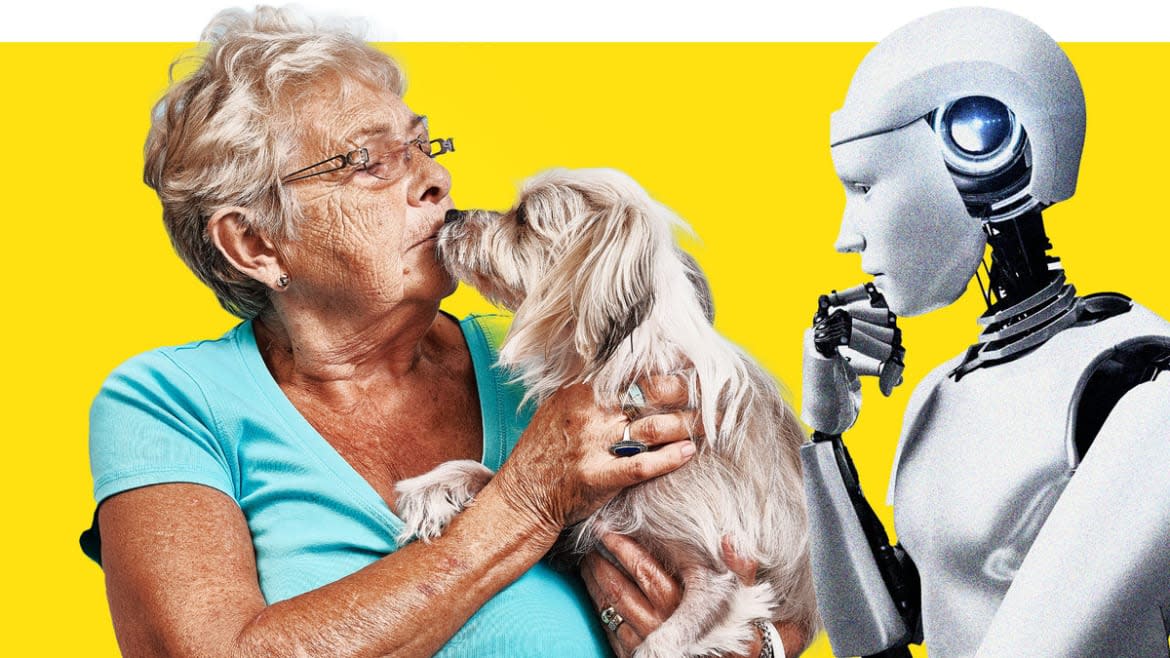A Dog’s Love Can Show Robots How to Love Us, Too

Any dog owner can tell you that there’s no love like the one a pup gives you. The way they wag their tail when you come home from work after a long day. The way they get excited when you bring out the leash to take them for a walk, or a tennis ball to toss around. The guilty look they give you when they sneak food off the kitchen counter or leave you “presents” on the brand new living room rug.
Dogs love humans—and it turns out, that bond can actually help us to train dog robots, too.
In a study published Wednesday in the journal PLOS ONE, researchers identified seven types of behavior people love to see in their dogs. The authors propose using these behaviors in order to help inform future social robots—specifically, ones that look and act like a real pooch. These mechanical canines can be used to “reduce loneliness and improve mental health,” the researchers write.
Roving Packs of Robot Dogs Are Coming to the Moon
“To facilitate long-term engagement with social robots, emerging evidence suggests that modeling robots on social animals with whom many people form enduring social bonds—specifically, pet dogs—may be useful,” the study says. It later adds that the research “provides a springboard for those hoping to implement dog behaviors into animal-like artificial agents.”
The study’s authors surveyed 153 dog owners about the types of behaviors they like to see in their pups. Owners responded with a variety of different types of actions they preferred such as nudging at them with their paw or being protective of the owner. In the end, the authors identified seven categories that are important in the human-dog bond: attunement, communication, consistency and predictability, physical affection, positivity and enthusiasm, proximity, and shared activities.
These behaviors could be programmed into robotic dogs to help make them friendlier, which would be beneficial in a number of ways. For one, training a robot dog to socialize with people is much easier than training a robot human. Not to insult all of the canine species, but their behavior is much more predictable and straightforward than their human counterparts.
This Robot Dog Learned to Walk in Just an Hour on Its Own
Also, the robo-pups can help provide the same mental health benefits for people as an actual dog, while avoiding issues like being bitten or having to take the dog on pesky walks every now and again. In fact, there’s already some research that suggests that robot pets might help enrich the lives of the elderly and dementia patients by giving them companions to socialize with—improving cognition and even physical health in some instances.
But there’s a big hairy issue researchers need to overcome: It might not actually be ethical to make robo-pups. After all, is it right to potentially mislead an elderly patient with dementia into thinking that they’re interacting with a dog instead of a robot?
To their credit, the study’s authors bring the issue up in the paper saying that problems like “human users misperceiving robotic pets as living beings, ethical issues of attachment, potential negative user reactions” and “hygiene and cost” all come into play. The study even quotes philosopher Robert Sparrow who wrote about the issue of robot companions two decades ago.
In the Future, We’ll Love Our Robot Pets, But Will They Love Us Back?
“For an individual to benefit significantly from ownership of a robot pet, they must systematically delude themselves regarding the real nature of their relation with the animal,” Sparrow wrote in a 2002 article for the journal Ethics and Information Technology. He later takes it a step further, adding that the “design and manufacture of these robots is unethical in so far as it presupposes or encourages this delusion.”
It’s worth noting that the authors don’t have a definitive solution to this issue—and even kind of punt the question by saying that it’s going to be something that the developers of potential robo-dogs have to deal with.
Regardless, the potential for benefit is there—as ethically confusing as it is. The authors write that they hope to build on the research and experiment with people interacting with robotic dogs trained on the behaviors they gleaned.
So one day we might see robo-pups at the dog park or walking on the sidewalk alongside their owner. For now, though, nothing’s going to beat having your actual pup run up to you to lick your face when you come home and curl up at your feet after a long day—though it might be nice if they could autonomously walk themselves.
Got a tip? Send it to The Daily Beast here
Get the Daily Beast's biggest scoops and scandals delivered right to your inbox. Sign up now.
Stay informed and gain unlimited access to the Daily Beast's unmatched reporting. Subscribe now.

